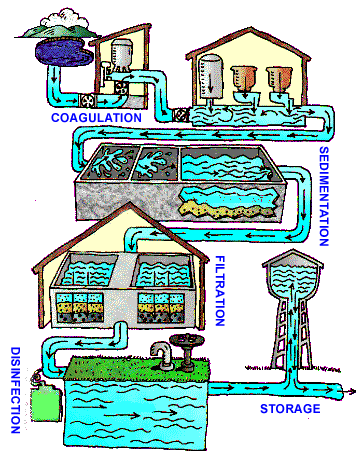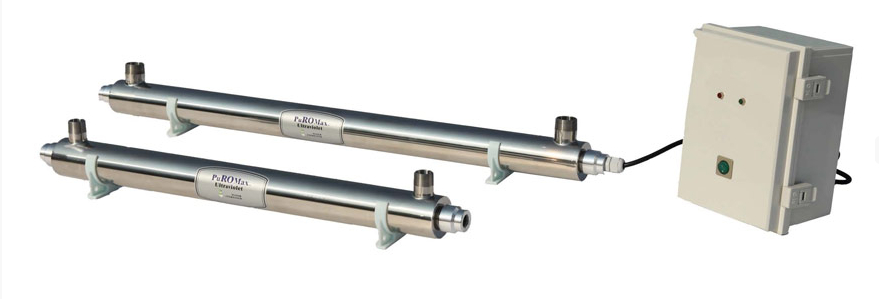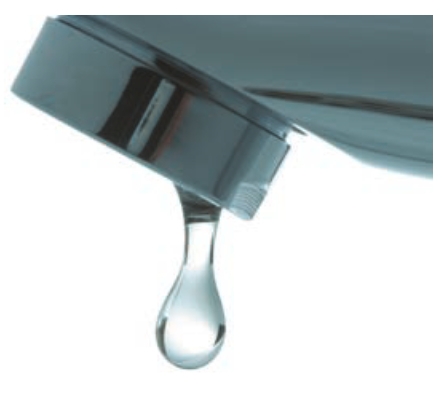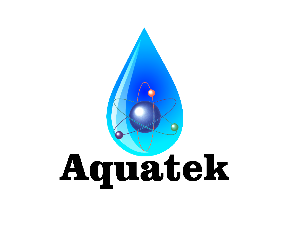Water treatment - water filtration - water purification meaning
What is water Water Treatment
Water, once it has been used travels to a water treatment plant where the water is treated to either release or recycle. Used water or sewage is refered to as Grey Water.
Community Water Treatment Processes
Drinking water supplies in the United States are among the safest in
the world. However, even in the U.S., drinking water sources can become
contaminated, causing sickness and disease from waterborne germs, such as Cryptosporidium, E. coli, Hepatitis A, Giardia intestinalis, and other pathogens.
Drinking water sources are subject to contamination and require
appropriate treatment to remove disease-causing agents. Public drinking
water systems use various methods of water treatment to provide safe
drinking water for their communities. Today, the most common steps in
water treatment used by community water systems (mainly surface water
treatment) include:
Coagulation and Flocculation
Coagulation and flocculation are often the first steps in water treatment. Chemicals with a positive charge are added to the water. The positive charge of these chemicals neutralizes the negative charge of dirt and other dissolved particles in the water. When this occurs, the particles bind with the chemicals and form larger particles, called floc.
Coagulation and flocculation are often the first steps in water treatment. Chemicals with a positive charge are added to the water. The positive charge of these chemicals neutralizes the negative charge of dirt and other dissolved particles in the water. When this occurs, the particles bind with the chemicals and form larger particles, called floc.
Sedimentation
During sedimentation, floc settles to the bottom of the water supply, due to its weight. This settling process is called sedimentation.
During sedimentation, floc settles to the bottom of the water supply, due to its weight. This settling process is called sedimentation.
Filtration
Once the floc has settled to the bottom of the water supply, the clear water on top will pass through filters of varying compositions (sand, gravel, and charcoal) and pore sizes, in order to remove dissolved particles, such as dust, parasites, bacteria, viruses, and chemicals.
Once the floc has settled to the bottom of the water supply, the clear water on top will pass through filters of varying compositions (sand, gravel, and charcoal) and pore sizes, in order to remove dissolved particles, such as dust, parasites, bacteria, viruses, and chemicals.
Disinfection
After the water has been filtered, a disinfectant (for example, chlorine, chloramine) may be added in order to kill any remaining parasites, bacteria, and viruses, and to protect the water from germs when it is piped to homes and businesses.
After the water has been filtered, a disinfectant (for example, chlorine, chloramine) may be added in order to kill any remaining parasites, bacteria, and viruses, and to protect the water from germs when it is piped to homes and businesses.

Learn more about water disinfection with chloramine and chlorine on the Disinfection page.
Water may be treated differently in different communities depending
on the quality of the water that enters the treatment plant. Typically,
surface water requires more treatment and filtration than ground water
because lakes, rivers, and streams contain more sediment and pollutants
and are more likely to be contaminated than ground water.
Some water supplies may also contain disinfections by-products,
inorganic chemicals, organic chemicals, and radionuclides. Specialized
methods for controlling formation or removing them can also be part of
water treatment.
To learn more about the steps that are taken to make our water safe to
drink, visit the United States Environmental Protection Agency’s (EPA) Public Drinking Water Systems webpage. To learn more about the 90+ contaminants EPA regulates and why, visit EPA’s Drinking Water Contaminants webpage.
Water Fluoridation
Community water fluoridation prevents tooth decay safely and
effectively. Water fluoridation has been named one of 10 great public
health achievements of the 20th century 1. For more information on the fluoridation process and to find details on your water system’s fluoridation, visit CDC’s Community Water Fluoridation page.
Consumer Confidence Reports
Every community water supplier must provide an annual report,
sometimes called a Consumer Confidence Report, or “CCR,” to its
customers. The report provides information on your local drinking water
quality, including the water’s source, contaminants found in the water,
and how consumers can get involved in protecting drinking water.
View the CDC’s guide to Understanding Consumer Confidence Reports.
See if your CCR is posted online. (United States Environmental Protection Agency Local Drinking Water Information)
See if your CCR is posted online. (United States Environmental Protection Agency Local Drinking Water Information)
What is water filtration?
Water filtration is the act of removing impurities by lowering contamination of water with a water filter used as a physical barrier or biological process. Filters cleanse water to different extents for purposes such as providing agricultural irrigation, accessible drinking water, public and private aquariums, and the safe use of ponds and swimming pools.

Water filters come in many different forms and have many different purposes. They are designed mainly, to remove a certain size of solid contaminant in a liquid. Most all filters are gauged in their ability to remove particles down to microns in size. Common filters for drinking water are 20 micron, 10 micron, 5 micron and 1 micron. Reverse Osmosis membranes are also considered a filter. See the reverse osmosis systems webpage for more information and learn why you should consider a reverse osmosis sytem for drinking water.
What is Water Sterilization?
Water sterlization is a means of killing live spores, bacteria or other germs that may be presnt in water. The advent of UV sterilization is very popular due to it's ability to kill a large amount of water quickly without the need to use caustic chemicals such as chlorine. UV systems are designed to have an effective contact time, for the UV light of the proper spectrum, to kill the amount of water passing through or around them. See more about UV sterilization here.

What is water purification?
Water purification is a combination of all technics listed above and the selection of which process to use is determined by water testing. It is not a one step process.
Water purification is the removal of
contaminants from raw water to produce drinking water that is pure
enough for human consumption or for industrial use.
Substances that are removed during the process
include parasites (such as Giardia or Cryptosporidium) , bacteria,
algae, viruses, fungi, minerals (including toxic metals such as Lead,
Copper etc.), and man-made chemical pollutants.
Many contaminants can be dangerous—but depending on the quality
standards, others are removed to improve the water's smell, taste, and
appearance.
A small amount of disinfectant is usually intentionally left in the
water at the end of the treatment process to reduce the risk of
re-contamination in the distribution system.
Many environmental and cost considerations affect the location and design of water purification plants.
Groundwater is cheaper to treat, but aquifers usually, have limited mass output and can take thousands of years to recharge.
Surface water sources should be carefully monitored for the presence
of unusual types or levels of microbial/disease causing contaminants.
The water treatment plant itself must be kept secure from vandalism and terrorism.
It is not possible to tell whether water is safe to drink just by looking at it.
Simple procedures such as boiling or the use of a household charcoal
filter are not always sufficient for treating water from an unknown source.
Even natural spring water - considered safe for all practical
purposes in the 1800s - must now be tested before determining what kind
of purification process is needed.

